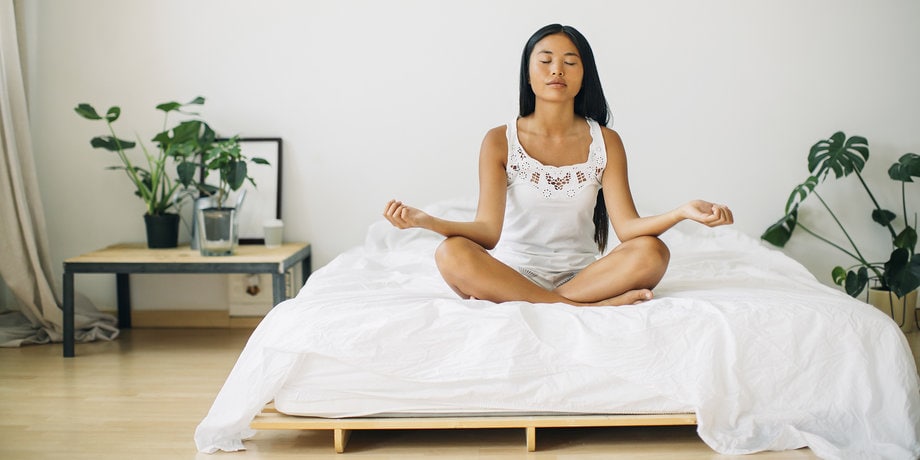Exploring Guided Sleep Meditation: Techniques for Restful Nights

Are you struggling to get a good night’s sleep? Discover the power of guided sleep meditation and unlock the secrets to restful nights.
In this article, we will explore the science behind this technique and the benefits it can bring to your nightly routine.
Learn about different types of guided sleep meditation techniques and how to create the perfect environment for optimal relaxation.
Find out how to choose the right app or program and overcome common challenges.
Get ready to integrate guided sleep meditation into your sleep hygiene routine and experience the transformative effects.
Key Takeaways
- Guided sleep meditation promotes a restful night’s sleep and helps relax the body and mind.
- Establishing a consistent routine for sleep meditation helps integrate it into daily life and maximizes its benefits.
- Planning a sleep meditation routine with specific timings helps create structure and predictability.
- Combining different meditation techniques such as breathing exercises, body scan, guided visualization, and mantra repetition enhances overall meditation practice and relaxation.
The Science Behind Guided Sleep Meditation
If you’re curious about the science behind guided sleep meditation, you’ll be fascinated to learn how it can promote restful nights.
Guided sleep meditation has a significant impact on sleep quality. When you engage in guided sleep meditation, your mind becomes focused on the present moment, allowing you to let go of racing thoughts and worries that often disrupt sleep.
This practice helps to calm your nervous system, reducing stress levels and promoting relaxation. By guiding your mind through various techniques, such as deep breathing and progressive muscle relaxation, guided sleep meditation induces a state of deep relaxation, making it easier for you to fall asleep and stay asleep throughout the night.
The relationship between guided sleep meditation and stress reduction is undeniable, as this practice helps to quiet the mind and release tension, leading to a more restful and rejuvenating sleep experience.
Benefits of Incorporating Guided Sleep Meditation Into Your Nightly Routine
You’ll experience improved sleep quality when you incorporate guided sleep meditation into your nightly routine. By practicing guided sleep meditation, you can reduce anxiety and create a calm state of mind before bedtime.
This form of meditation helps you relax your body and mind, allowing you to let go of the day’s worries and stresses. As a result, you’ll find it easier to fall asleep and stay asleep throughout the night.
Guided sleep meditation also promotes a deeper and more restful sleep, which is essential for waking up feeling refreshed and energized. It can help alleviate insomnia and other sleep disorders, providing you with the restful nights you’ve been longing for.
Different Types of Guided Sleep Meditation Techniques
There are various types of guided sleep meditation techniques that can enhance your nightly routine and promote better sleep quality. Here are some options for you to explore:
- Body scan meditation: This technique involves focusing your attention on different parts of your body, starting from your toes and moving up to your head. It helps you relax and release tension, allowing you to drift off into a peaceful sleep.
- Visualization meditation: With this technique, you imagine yourself in a calm and serene environment, such as a beach or a forest. By visualizing these tranquil scenes, you can create a sense of relaxation and ease, preparing your mind for a restful sleep.
- Loving-kindness meditation: This technique involves generating feelings of love, compassion, and goodwill towards yourself and others. By cultivating these positive emotions, you can let go of any stress or negativity, promoting a sense of inner peace and tranquility before bedtime.
- Breathing meditation: This technique focuses on your breath, guiding you to pay attention to the rhythm and sensations of each inhale and exhale. By centering your attention on your breath, you can calm your mind and prepare it for a deep and rejuvenating sleep.
Exploring these different types of guided sleep meditation techniques can bring numerous benefits to your sleep routine, such as reducing stress, improving sleep quality, and promoting overall well-being. So why not give them a try and experience the wonders of guided sleep meditation for yourself?
How to Create the Perfect Environment for Guided Sleep Meditation
To create the perfect environment for guided sleep meditation, there are a few key steps to follow.
First, make sure your bedroom is free from distractions and has a comfortable and calming atmosphere. This means decluttering your space and removing any electronic devices or work-related items. Keeping your bedroom solely for relaxation and sleep will help signal to your brain that it’s time to wind down.
Next, focus on the ambiance. Soft lighting, such as dimmed lamps or candles, can create a soothing atmosphere. Consider using aromatherapy to enhance relaxation. Essential oils like lavender or chamomile can be diffused or applied to a pillow to promote calmness and tranquility.
Finally, ensure your bed and bedding are comfortable and inviting. This will allow you to fully relax and let go of the day’s stresses. Investing in a supportive mattress and high-quality bedding can make a big difference in the quality of your sleep.
Tips for Finding the Right Guided Sleep Meditation App or Program
Finding the right guided sleep meditation app or program can be a challenge, but it’s worth it to enhance your sleep quality and overall relaxation. To help you in your search, consider the following tips:
- User Reviews: Look for apps or programs with positive reviews from other users. Their experiences can give you a sense of what to expect.
- Program Features: Evaluate the features offered by different apps or programs. Some may include soothing background sounds, customizable meditation sessions, or sleep tracking capabilities.
- Guided Meditations: Pay attention to the quality and style of the guided meditations. Find a voice and approach that resonates with you, whether it’s a soothing tone or a particular meditation technique.
- Free Trials or Demos: Take advantage of free trials or demos to get a feel for the app or program before committing. This allows you to evaluate its effectiveness and compatibility with your needs.
Common Challenges and Solutions in Guided Sleep Meditation
One common challenge you may face when practicing guided sleep meditation is maintaining focus and preventing your mind from wandering. It’s natural for thoughts to pop up and distract you, but it’s important to stay present and focused on the meditation.
A solution to this is to acknowledge the thoughts without judgment and gently bring your attention back to the guided meditation.
Another challenge you may encounter is difficulty in relaxing your body and mind. To overcome this, try incorporating deep breathing exercises and progressive muscle relaxation techniques into your guided sleep meditation practice. These techniques help release tension and promote relaxation.
Additionally, some people may struggle with finding the right guided sleep meditation program or app that suits their needs. The solution is to explore different options and experiment until you find one that resonates with you and helps you achieve restful nights.
Integrating Guided Sleep Meditation Into Your Overall Sleep Hygiene Routine
If you want to maximize the benefits of sleep meditation, it’s important to establish a consistent routine.
By incorporating guided sleep meditation into your overall sleep hygiene routine, you can create a bedtime ritual that promotes relaxation and deep rest.
Additionally, combining different meditation techniques, such as mindfulness and visualization, can enhance the effectiveness of your sleep meditation practice.
Maximizing Sleep Meditation Benefits
To maximize the benefits of sleep meditation, you need to focus on deep breathing and visualizing peaceful scenes. By incorporating these techniques into your routine, you can improve your sleep quality and enhance the overall benefits of meditation.
So, take a deep breath and let yourself relax as you imagine:
- A calm and serene beach, with gentle waves lapping against the shore.
- A peaceful forest, with sunlight streaming through the branches and birds chirping softly.
- A tranquil garden, filled with colorful flowers and the soothing sound of a trickling fountain.
- A cozy cabin in the mountains, surrounded by majestic scenery and the quiet rustling of leaves.
As you breathe deeply and visualize these scenes, allow your body and mind to fully relax, promoting a restful night’s sleep and maximizing the benefits of your sleep meditation practice.
Establishing a Consistent Routine
Now that you understand the benefits of sleep meditation, it’s time to establish a consistent routine to make the most out of your practice. Creating habits can help you integrate sleep meditation seamlessly into your daily life. By following a regular schedule, your mind and body will gradually become accustomed to this practice, making it easier for you to relax and unwind.
To help you get started, here’s a simple table to plan your sleep meditation routine:
| Time | Activity |
|---|---|
| 8:00 PM | Prepare for bed |
| 8:30 PM | Begin sleep meditation |
| 8:45 PM | Focus on breathing and visualization |
| 9:00 PM | End sleep meditation |
| 9:15 PM | Reflect on your experience |
| 9:30 PM | Sleep |
Combining Meditation Techniques
Combining different meditation techniques can enhance your overall practice and deepen your relaxation experience. By incorporating various methods, you allow yourself to explore a range of approaches and techniques that can help you achieve a state of deep relaxation.
Here are four techniques to consider:
- Breathing exercises: Focus on your breath, inhaling deeply and exhaling slowly. Feel the tension leaving your body with each breath.
- Body scan: Start from your toes and slowly work your way up, paying attention to each part of your body. Release any tension you may feel along the way.
- Guided visualization: Imagine yourself in a peaceful and serene place, such as a beach or a forest. Visualize the sights, sounds, and smells, allowing yourself to fully immerse in the experience.
- Mantra repetition: Choose a word or phrase that resonates with you and repeat it silently or aloud. Let the vibrations of the mantra bring you a sense of calm and tranquility.
Frequently Asked Questions
How Long Does It Typically Take to See Results From Guided Sleep Meditation?
On average, how long does it typically take to see results from guided sleep meditation? It varies for each individual. However, many people notice improvements in sleep quality and relaxation within a few weeks of consistent practice.
Can Guided Sleep Meditation Help With Specific Sleep Disorders, Such as Insomnia or Sleep Apnea?
Guided sleep meditation can be effective in managing sleep disorders like insomnia or sleep apnea. A comprehensive review on its effectiveness in managing sleep disorders reveals the positive impact it can have.
Is It Necessary to Use a Guided Sleep Meditation App or Program, or Can I Do It on My Own?
You don’t need a guided sleep meditation app or program to create a personalized routine. Self-guided sleep meditation can be just as effective. It allows you to tailor the techniques to your specific needs and enjoy the benefits.
Are There Any Potential Side Effects or Risks Associated With Guided Sleep Meditation?
There may be potential side effects or risks associated with guided sleep meditation. It’s important to be aware of these and consult with a healthcare professional if you experience any negative effects.
Can Guided Sleep Meditation Be Used as a Replacement for Medication or Other Sleep Aids?
Yes, guided sleep meditation can be used as an alternative to medication or other sleep aids. It offers numerous benefits when incorporated into your bedtime routine, such as relaxation and improved sleep quality.









